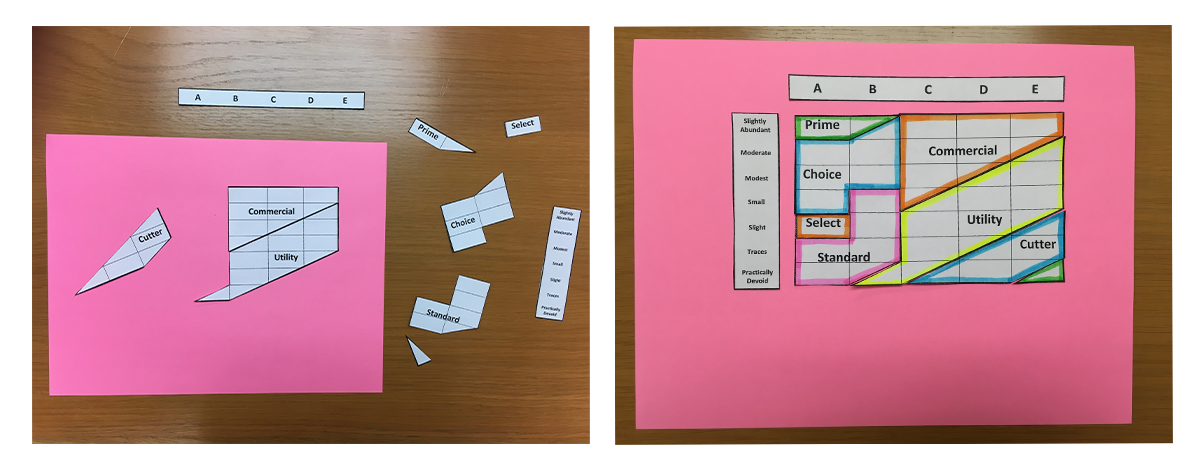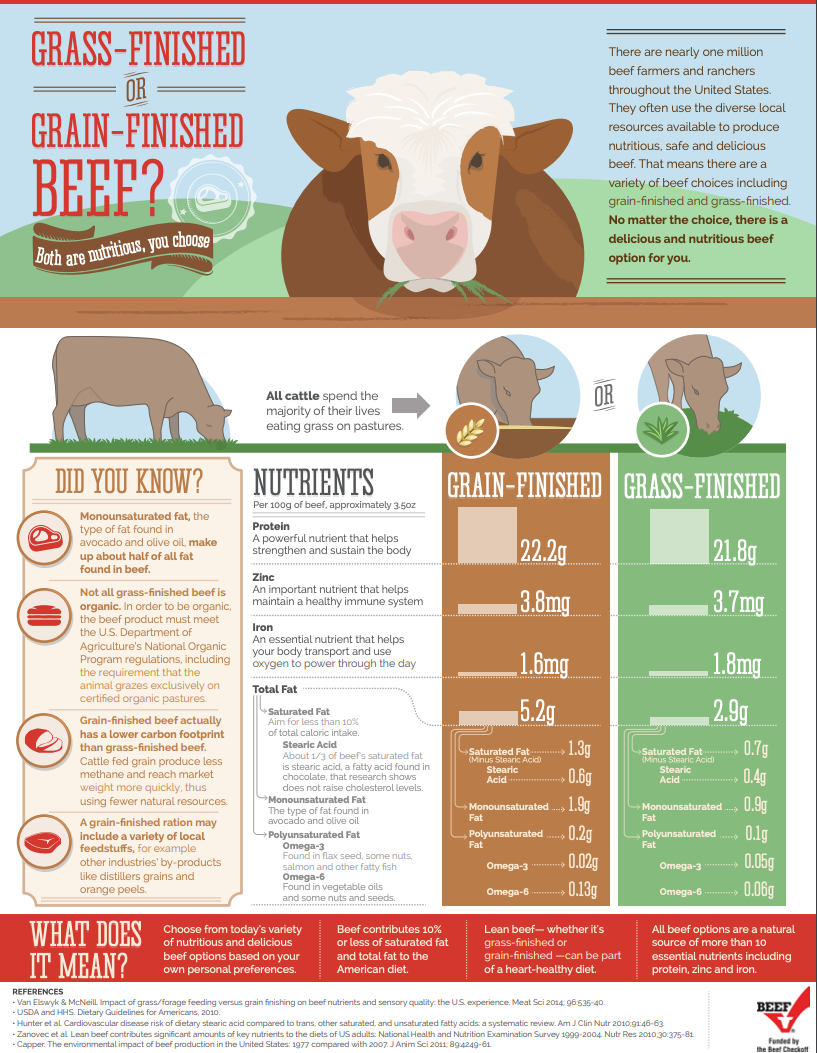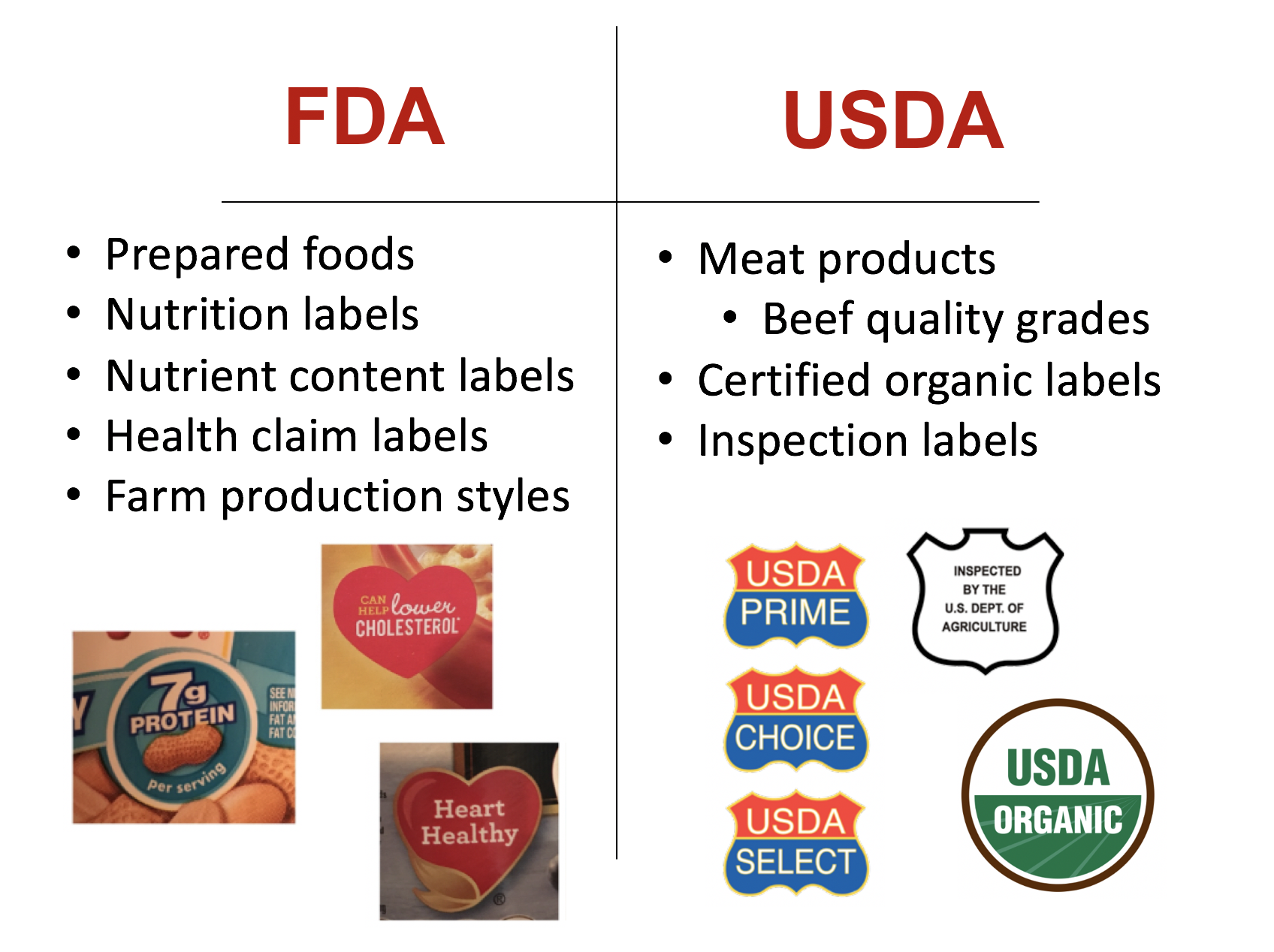Puzzle of Beef Cuts on a Carcass
educator center
Agricultural Literacy Curriculum Matrix
Lesson Program
Beef: Making the Grade
Purpose
Students will evaluate the USDA grading organization for whole cuts of beef and discuss consumer preferences and nutritional differences between grain-finished and grass-finished beefiness. Students will also distinguish various labels on beef products and discuss reasons for the government's involvement in agronomical production, processing and distribution of food.Grades 9-12
Materials Needed
Interest Approach
- Scissors
- Glue sticks
- USDA Quality Grade Puzzle, 1 re-create per student
- Grading Beefiness PowerPoint slides
- Blank slice of cardstock/structure paper, i per student
- Colored pencils or markers (optional)
Activity 1
- Completed USDA Quality Class Puzzle (from Involvement Arroyo)
- Grading Beef PowerPoint slides
Activity 2
- Grading Beef PowerPoint slides
- Beefiness Labels handout, 1 re-create per student
- Grass-finished or Grain-finished beef? infographic
Vocabulary Words
concentrate: creature feed that contains low amounts of fiber and loftier amounts of energy
finishing weight: the weight cattle attain (usually between i,200 and 1,500 pounds) when they are ready for harvesting
fodder: bulky food such as grass or hay typically consumed past livestock
grain: the edible seed or seed-similar fruit of grasses that are cereals (such every bit wheat, corn, and rice)
harvest: to impale or slaughter an animal for human use
marbling: the white streaks of fat found inside the meat
regulate: command or supervise by means of rules and regulations
United States Department of Agriculture (USDA): a federal bureau responsible for developing and executing federal laws related to farming, forestry, and food
USDA quality class: a grade given to whole cuts of beef based on the age of beef and degree of marbling
weaning: when a immature mammal no longer receives milk from its mother
Did Yous Know? (Ag Facts)
- U.S. farmers and ranchers produce 18% of the world's beefiness with simply 8% of the globe's cattle.1
- Monounsaturated fat—the fat found in avocados and olive oil—makes up about half of all fatty found in beef. 2
- Non all grass-finished beef is organic. In order to exist organic, the beef must run across the USDA'southward organic regulations which requires cattle to exclusively graze on certified organic pastures.2
- Grain-finished beef has a lower carbon footprint than grass-finished beef. Cattle that are fed grain produce less methane and reach market place weight more quickly, thus using fewer natural resources. 2
Background Agricultural Connections
Beef can be found on dinner tables and in restaurants worldwide. Every bit consumers select beef entrées from a carte du jour or purchase steaks at the grocery store, they may see a broad variety of product labels and beef terminology that raise questions. What does USDA Prime mean? Why is this steak more expensive than the others? Do I want grass-finished beef or grain-finished beefiness?
At that place are many factors to consider when purchasing beef, including theUSDA quality gradeand food production system labels. When there is a high demand for a specific type of beef, cattle ranchers typically produce products that meet consumer needs and preferences. Following consumer demand, some cattle producers choose to raise their cattle following the requirements to label the beef equally "organic." Other cattle producers might raise grass-fed beef for consumers who adopt lean meat. It is important for consumers to sympathise each of these factors so they can make informed decisions and select beef that meets their needs.
USDA Quality Grade
Whole cuts of beefiness are given a quality grade by USDA meat graders. Quality grades act as a language within the beef industry and are based off of the degree of marbling plant within the meat, likewise as the historic period and maturity of the beef.
- Prime number: Prime beef comes from immature cattle who are well-fed. The meat has abundant marbling and tin typically exist found in restaurants and hotels.
- Selection: Choice beefiness is considered high quality, but has less marbling than Prime number. Roasts and steaks from the rib and loin volition be very juicy, tender, and full of flavor.
- Select: Select beefiness is leaner than Prime and Choice. It may still be tender, but will lack season and juiciness due to less marbling. It is suggested that many Select cuts should be marinated before cooking to maximize flavor.
- Standard and Commercial: Standard and Commercial course beef is typically sold every bit ungraded or store brand meat.
- Utility and Canner: Utility and Canner beef is rarely sold at retail, but tin be used to brand ground beef and other candy products.
Grass-finished Beef vs. Grain-finished Beefiness
Some consumers have an increased interest to know how cattle were fed earlier the beef was harvested. Grass-fed or grass-finished labels can exist establish on beef products in grocery stores. Grain-fed labels do be; however, they are typically not put on beef packages because nigh beef is raised that manner. What nigh consumers don't realize is that all cattle spend the majority of their lives eating grass and fodder products. Calves are raised with their mother on pasture or grass until they are betwixt 6-12 months of age. After weaning, cattle are then fed to a finishing weight for harvesting. This is where cattle volition be considered eithergrass-finished or grain-finished. Grass-finished cattle take longer to reach a finishing weight; however, it is cheaper to raise cattle on grass and pasture rather than feeding grain. Without grain and concentrates in the nutrition, the meat will be bacteria. Some consumers prefer meat that is lean and less fatty. Cattle that are finished on a grain diet fatten up and reach a finishing weight faster than grass-finished cattle. The marbling that comes from a grain nutrition makes a steak juicy, tender, and flavorful. Meat that is graded USDA Prime, USDA Selection, or USDA Select are typically more expensive because they take the almost marbling. There are slight nutritional differences between grass-finished beef and grain-finished beef; however, all beef is packed with protein and a 3-oz serving of either kind will supply consumers with 50% of their recommended Daily Value of protein.1 Grass- and grain-finished beef are both nutritious, and consumers should purchase meat that best fits their needs and preferences.
Farm production System Labels
Production organization labels used on beefiness products betoken how cattle were raised and fed earlier harvesting. Organic and Naturally Raised labels are commonly establish among grass- and grain-finished beefiness products. Consumers should make certain that organic beef includes the green and white "USDA Organic" label. Refer to the Decoding Labels infographic produced by the Beef Council for specifications of each label.

Image from Decoding the Label: Know Your Beef Choices created by the Beefiness Council
Interest Approach - Engagement
- Project slide one from the Grading Beefiness PowerPoint on the board.
- Inquire students the following questions to lead a class discussion:
- Exercise cattle really receive grades?
- What kind of grades practise we give beef cattle?
- How do grades touch consumers?
- Pass out a USDA Quality Grade Puzzle to each student or each pair of students.
- Instruct students to cut out each of the puzzle pieces.
- Have each pupil or pair of students race to put the puzzle together.
- Instruct students to glue their puzzle together onto the bare sheet of paper. Students may also color-code each section on the calibration for easier reading. (A-E should be placed in a higher place the calibration, and the degrees of marbling should be placed to the side of the scale.)
- Ask students to examine the puzzle once they are finished. Enquire the post-obit questions to lead a class discussion:
- What are the words on the puzzle referring to?
- Take you noticed any of these words somewhere? Try to atomic number 82 students to call up seeing "prime" and "choice" in a eating place or grocery store.
- Inform students that they are going to apply this puzzle (grading scale) to acquire more about the beef they eat and how cuts of meat receive grades.

Procedures
Activity i: Grading Beef
- Explain to students that subsequently cattle are harvested, the carcass and whole cuts of meat are given a grade. Ask students the following questions:
- How is the scale used to form beefiness?
- Why is beef graded?
- What factors impact the grade given to cuts of meat?
- Explain to students that in lodge to be harvested, cattle should be fed to a specific weight. This is called a finishing weight. When the meat is harvested, meat inspectors will course the beefiness based on 2 things: maturity (age) of the beef carcass and how much marbling it has. Columns A through Due east on the chart refer to the age of beef and rows slightly abundant through practically devoid refers to the corporeality of marbling.
- Instruct students make note of the following beef ages on their puzzles:
- A: ix-30 months
- B: 30-42 months
- C: 42-72 months
- D: 72-96 months
- East: >96 months
- Ask students the following questions to lead a form discussion:
- What is marbling?
- What causes marbling?
- Project the Grading Beef slide (slide two) on the lath.
- Ask students to compare the caste of marbling in each of the photos.
- Using the side by side six slides, instruct students or pairs of students to grade each photograph based on its age and the degree of marbling. Allow students to use their puzzles to decide the quality grades of each photo.
- Once students accept determined a grade for a photograph, have them place the corresponding number on their puzzles where information technology belongs. (Each photo is numbered.)
- Discuss students' results on each slide.
Activity 2: Grain-finished vs. Grass-finished
- Inquire students how the diet of cattle could bear upon the USDA form.
- Allow students to brainstorm possible answers.
- Project the Beefiness Labels slide (slide nine) from the PowerPoint on the lath.
- Explicate to students that many of the labels they see on beef packages requite consumers an idea of how that beefiness was fed and raised.
- Pass out a Beef Labels handout to each student.
- Ask students to examine each of the labels and write their own interpretations of each label.
- What kind of diet did this animal take?
- How was it raised?
- What does this label mean?
- Discuss each of the labels with students and their interpretations.
- Project the next four slides (ten-thirteen) on the board.
- Enquire students to write the facts about each characterization below their interpretations.
- Were any of their interpretations right?
- What surprised students nearly the characterization facts?
- What did students assume about the nutrition of cattle from beef labeled organic or natural?
- Is all grass-fed beef considered organic?
- Tin can grain-fed cattle be organic?
- Projection the Cattle Lifecycle slide (slide xiv) on the board. Betoken out to students that all cattle spend the majority of their lives eating grass, but they can be fed (finished) differently to reach a harvesting weight.
- Ask students to make a connection betwixt the diet of cattle and USDA grades.
- Subsequently students have brainstormed possible answers, refer to the Background Agronomics Connection paragraph to discuss the questions beneath:
- Does grain or grass produce more than marbling?
- Why are Prime and Pick cuts of beef more expensive?
- Ask students to create a T-chart comparison grain-finished beef vs. grass-finished beef.
- Once students take fabricated their ain comparisons, employ the Grass-Finished or Grain-finished Beef infographic provided past the Beef Council to hash out similarities and differences.
- Is in that location a nutritional departure between grass-finished beef and grain-finished beef?
- Do consumer needs/preferences affect what product farmers and ranchers produce?
- Why practise some consumers prefer grass-finished beef vs grain-finished beef?
- What are the health benefits of eating beef?

Infographic created past the Beefiness Council
Activity 3: Label Regulations: Who's in Charge?
- Ask students what "regulate" means.
- Let students to discuss the words "regulate" and "regulations". Where accept they heard these words earlier?
- Refer to the labels in Activity 2 (slide 15).
- Inquire students to think virtually these beef labels and other labels they meet on food products and ask them, "Who regulates the employ of labels on our nutrient? Is it farmers? Ranchers? Nutritionists?" Allow students to brainstorm and discuss answers.
- Explain to students that the Food and Drug Assistants (FDA) and United states of america Department of Agronomics (USDA) each regulate and oversee specific labels on nutrient products.
- (Slide 16) Permit students to read and analyze the bulleted lists in each column. Which government plan regulates the labels on the left? Which government program regulates the labels on the right? Reveal the answers on the PowerPoint.

- Explain to students that the FDA regulates labels on all prepared food items such as breads, cereals, canned and frozen food, snacks, etc. The USDA uses a shield-shaped label and regulates labeling on all meat products including beefiness, pork, and poultry. This includes the beef quality grades students explored in Activity 1. Refer to the USDA Labeling Terms to read more about specific meat characterization terminology.
- Inform students that the USDA as well oversees regulations for all certified organic products*.
- Explicate to students that some prepared nutrient items might accept an FDA label as well as a USDA Certified Organic label. If that is the instance, the production must meet both FDA'southward and USDA's regulations.
- Promote critical thinking amidst your students by asking the following questions:
- Why do the FDA and USDA regulate nutrient labels?
- How does food labeling bear on farmers and ranchers?
- Does food labeling touch consumer choices?
- What does it hateful if a product is labeled "organic" only information technology'due south not a USDA organic label?
- Can labels be misleading or disruptive?
- Encourage students to explore food labels on products at home or the grocery store.
*Some operations are exempt from certification, including organic farmers whose gross income is $5,000 or less. People who sell or characterization a product "organic" when they know it does not meet USDA standards can exist fined up to $eleven,000 for each violation.8
| | Students should recognize that some labels are regulated past the USDA or FDA and accept strict guidelines to qualify for their use. The USDA Organic seal and beef quality grades are examples. Other labels (such as "Grass-fed") are either not regulated or are regulated by private organizations who set their ain criteria. Consumers should use critical thinking when determining nutrient choices based on labels. |
Concept Elaboration and Evaluation
After conducting these activities review and summarize the following key points:
- Food labels impact consumer choices.
- Following the laws of supply and need, as consumers cull specific products and market demand increases, farmers and ranchers respond by increasing production co-ordinate to demand.
- Quality grades of beef are outlined by the USDA.
Enriching Activities
-
Explore the Beefiness Council'southward Infographic Library for more information about quality grades, the beef lifecycle, cuts of beef, food safety, and diet facts.
-
This lesson explores labels found on beef. Use the Looking Nether the Label lesson to explore labels found on all types of foods.
Organization Affiliation
Utah Agriculture in the Classroom
| | We welcome your feedback. Delight take a minute to share your thoughts on this lesson. |
Source: https://minnesota.agclassroom.org/matrix/lesson/698/
0 Response to "Puzzle of Beef Cuts on a Carcass"
Enviar um comentário